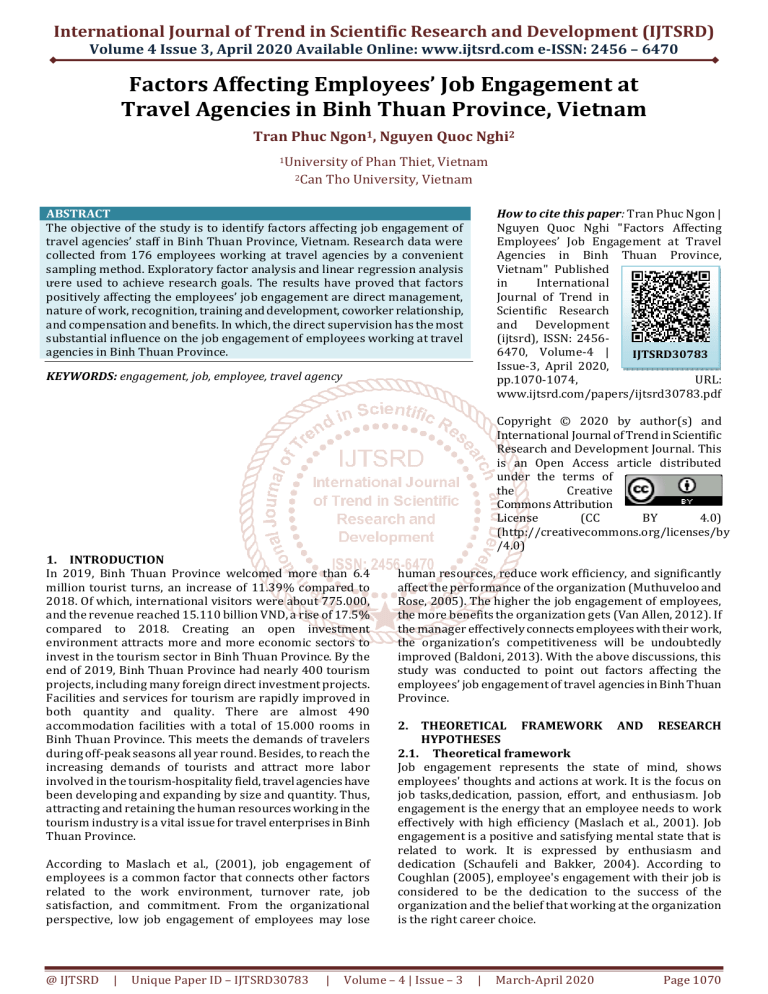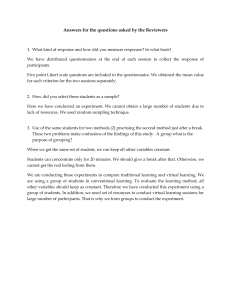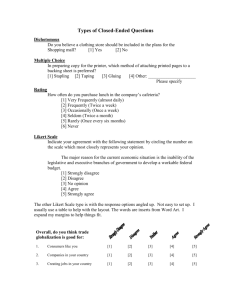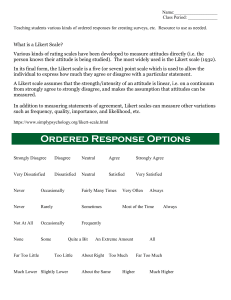
International Journal of Trend in Scientific Research and Development (IJTSRD)
Volume 4 Issue 3, April 2020 Available Online: www.ijtsrd.com e-ISSN: 2456 – 6470
Factors Affecting Employees’ Job Engagement at
Travel Agencies in Binh Thuan Province, Vietnam
Tran Phuc Ngon1, Nguyen Quoc Nghi2
1University
2Can
of Phan Thiet, Vietnam
Tho University, Vietnam
ABSTRACT
The objective of the study is to identify factors affecting job engagement of
travel agencies’ staff in Binh Thuan Province, Vietnam. Research data were
collected from 176 employees working at travel agencies by a convenient
sampling method. Exploratory factor analysis and linear regression analysis
ưere used to achieve research goals. The results have proved that factors
positively affecting the employees’ job engagement are direct management,
nature of work, recognition, training and development, coworker relationship,
and compensation and benefits. In which, the direct supervision has the most
substantial influence on the job engagement of employees working at travel
agencies in Binh Thuan Province.
How to cite this paper: Tran Phuc Ngon |
Nguyen Quoc Nghi "Factors Affecting
Employees’ Job Engagement at Travel
Agencies in Binh Thuan Province,
Vietnam" Published
in
International
Journal of Trend in
Scientific Research
and Development
(ijtsrd), ISSN: 24566470, Volume-4 |
IJTSRD30783
Issue-3, April 2020,
pp.1070-1074,
URL:
www.ijtsrd.com/papers/ijtsrd30783.pdf
KEYWORDS: engagement, job, employee, travel agency
Copyright © 2020 by author(s) and
International Journal of Trend in Scientific
Research and Development Journal. This
is an Open Access article distributed
under the terms of
the
Creative
Commons Attribution
License
(CC
BY
4.0)
(http://creativecommons.org/licenses/by
/4.0)
1. INTRODUCTION
In 2019, Binh Thuan Province welcomed more than 6.4
million tourist turns, an increase of 11.39% compared to
2018. Of which, international visitors were about 775.000,
and the revenue reached 15.110 billion VND, a rise of 17.5%
compared to 2018. Creating an open investment
environment attracts more and more economic sectors to
invest in the tourism sector in Binh Thuan Province. By the
end of 2019, Binh Thuan Province had nearly 400 tourism
projects, including many foreign direct investment projects.
Facilities and services for tourism are rapidly improved in
both quantity and quality. There are almost 490
accommodation facilities with a total of 15.000 rooms in
Binh Thuan Province. This meets the demands of travelers
during off-peak seasons all year round. Besides, to reach the
increasing demands of tourists and attract more labor
involved in the tourism-hospitality field, travel agencies have
been developing and expanding by size and quantity. Thus,
attracting and retaining the human resources working in the
tourism industry is a vital issue for travel enterprises in Binh
Thuan Province.
According to Maslach et al., (2001), job engagement of
employees is a common factor that connects other factors
related to the work environment, turnover rate, job
satisfaction, and commitment. From the organizational
perspective, low job engagement of employees may lose
@ IJTSRD
|
Unique Paper ID – IJTSRD30783
|
human resources, reduce work efficiency, and significantly
affect the performance of the organization (Muthuveloo and
Rose, 2005). The higher the job engagement of employees,
the more benefits the organization gets (Van Allen, 2012). If
the manager effectively connects employees with their work,
the organization’s competitiveness will be undoubtedly
improved (Baldoni, 2013). With the above discussions, this
study was conducted to point out factors affecting the
employees’ job engagement of travel agencies in Binh Thuan
Province.
2. THEORETICAL FRAMEWORK AND RESEARCH
HYPOTHESES
2.1. Theoretical framework
Job engagement represents the state of mind, shows
employees' thoughts and actions at work. It is the focus on
job tasks,dedication, passion, effort, and enthusiasm. Job
engagement is the energy that an employee needs to work
effectively with high efficiency (Maslach et al., 2001). Job
engagement is a positive and satisfying mental state that is
related to work. It is expressed by enthusiasm and
dedication (Schaufeli and Bakker, 2004). According to
Coughlan (2005), employee's engagement with their job is
considered to be the dedication to the success of the
organization and the belief that working at the organization
is the right career choice.
Volume – 4 | Issue – 3
|
March-April 2020
Page 1070
International Journal of Trend in Scientific Research and Development (IJTSRD) @ www.ijtsrd.com eISSN: 2456-6470
2.2. Research hypotheses
Studies by Schaufeli and Bakker (2004), Hewitt (2014),
Bakker and Demerouti (2008), Malik et al., (2010), Azeem
and Akhtar (2014) have demonstrated factors such as direct
management, recognition, and colleague relation positively
affect employees’ job engagement. Besides, Malik et al.,
(2010), Azeem and Akhtar (2014), Araya and Haiyan (2015),
Nguyen (2016) have confirmed that the nature of work is an
essential factor affecting the engagement with the job of
employees. Furthermore, findings in studies by Martensen
and Grønholdt (2006), Chughtai and Zafar (2006), Azeem and
Akhtar (2014), Araya and Haiyan (2015) have stressed the
positive impact of training and development opportunities on
the employee's commitment to the work. Finally, Malik et al.,
(2010), Azeem and Akhtar (2014), Araya and Haiyan (2015),
Nguyen (2016) showed the powerful influence of
compensation and benefits on job engagement of the staff.
Factor
Direct management
Nature of work
Recognition
Training and
development
Coworker relationship
Compensation and
benefits
Job engagement
@ IJTSRD
|
Based on the literature review, the study used the group
discussion method (qualitative research) with tourism experts
and employees working in travel agencies in Binh Thuan
Province. The results of the discussion set out research
hypotheses and appropriate scales for the research model.
Research hypotheses: H1: Direct management positively
impacts employee engagement. H2: The nature of work
positively affects employees’ job engagement. H3: Recognition
positively influences employee engagement. H4: Training and
development opportunities positively affects employees’ job
engagement. H5: Coworker relationship positively impacts
employee engagement. H6: Compensation and benefits
positively impact employee engagement. Therefore, the
following research model is stated.
Figure 1: Proposed research model
Table 1: Interpretation of observations in the research model
Observed variables
The work assignment is scientific and logical.
The treatment is fair, and the feedback is always listened to.
Job responses are provided regularly.
Support and help from the manager are offered.
Professional competence is suitable for the job.
Understand and catch up with the nature of work.
Understand the requirements, responsibilities, and powers of
each employee.
Have opportunities to use skills and creativity at work.
Achievements are always rewarded.
Useful ideas are widely applied.
The leader and colleagues recognize contributions.
Feel valued at work.
The organization has training courses in skills and professional
qualifications.
The organization focuses on training and updating work-related
knowledge.
The ỏganization always chooses the right people in promotion
decisions.
The organization gives promotion opportunities consistent with
each employee’s capacity.
Colleagues always cooperate well.
Feel like a part of a capable team.
The relationships among colleagues are good.
Colleagues always trust each other.
The salary is commensurate with the workload.
Rewards/punishments are clear and reasonable.
The welfare policy is excellent and flexible.
The income is highly competitive in the tourism market.
Compensation and benefits are always paid on time.
Make efforts to complete assigned tasks.
Always be proud of the current job.
Will engage with the job in the long term.
Unique Paper ID – IJTSRD30783
|
Volume – 4 | Issue – 3
|
Sign
DM1
DM2
DM3
DM4
NOW1
NOW2
Scale
Likert 1-5
Likert 1-5
Likert 1-5
Likert 1-5
Likert 1-5
Likert 1-5
NOW3
Likert 1-5
NOW4
REC1
REC2
REC3
REC4
Likert 1-5
Likert 1-5
Likert 1-5
Likert 1-5
Likert 1-5
TAD1
Likert 1-5
TAD2
Likert 1-5
TAD3
Likert 1-5
TAD4
Likert 1-5
CR1
CR2
CR3
CR4
CAB1
CAB2
CAB3
CAB4
CAB5
JE1
JE2
JE3
Likert 1-5
Likert 1-5
Likert 1-5
Likert 1-5
Likert 1-5
Likert 1-5
Likert 1-5
Likert 1-5
Likert 1-5
Likert 1-5
Likert 1-5
Likert 1-5
March-April 2020
Page 1071
International Journal of Trend in Scientific Research and Development (IJTSRD) @ www.ijtsrd.com eISSN: 2456-6470
3. RESEARCH METHODOLOGY
3.1. Analytical methods
The quantitative determination of factors affecting employee engagement in travel enterprises is conducted in 3 steps. Step 1:
Use the Cronbach’s Alpha to test reliability and the internal consistency among observed variables. Step 2: Use the exploratory
factor analysis (EFA) to assess the convergent and discriminant validity of observed variables. Step 3: Use the multivariate
linear regression to test the research hypotheses.
3.2. Data collection method
The study used a convenience sampling method to survey 176 employees who are working at travel agencies in Binh Thuan
Province. According to Hair et al. (1998), to apply exploratory factor analysis (EFA), the proportion between observations and
the measured variable is 5:1, meaning that each measured variable requires at least 5 items. As reported by Tabachnick and
Fidell(2007), the appropriate sample size for linear regression is N ≥ 50 + 5*m (where m is the number of independent
variables). Thus, the sample size achieves the reliability requirement for testing research hypotheses.
4. RESEARCH RESULTS AND DISCUSSIONS
4.1. Evaluate the reliability of the scales
The Cronbach's Alpha was used to eliminate variables with "garbage" values and variables with Item-total correlation less than
0.3 (Nunnally, 1978; Peterson, 1994; Slater, 1995). The scales are satisfactory if Cronbach's Alpha coefficients are more
significant than 0.6 (Nunnally and Bernstein, 1994). The analysis result in Table 2 shows that the scales have high Cronbach's
Alpha values (the minimum is 0.752) and the Item-total correlation of each observation meets the requirement (the minimum
is 0.325). Therefore, all variables can be includes in the exploratory factor analysis (EFA).
Table 2: Scale reliability test result
Number of variables Minimum item-total correlation
Factor
Cronbach's Alpha
Direct management
4
0.552
0.804
Nature of work
4
0.496
0.752
Recognition
4
0.325
0.757
Training and development
4
0.492
0.787
Coworker relationship
4
0.465
0.790
Compensation and benefits
5
0.504
0.775
3
0.560
Source: Survey data, 2020
0.752
Job engagement
4.2. Exploratory factor analysis (EFA)
According to the EFA result for independent variables, the coefficients are guaranteed as follows: The significance level of the
model (Sig) is less than 0.05 and the KMO = 0.738 (in the range of 0 to 1); the factor loading values of all observations are more
significant than 0.5; the cumulative variance test is 65.217% > 50%. This shows that the research data is satisfactory (Anderson
and Gerbing, 1988). As a result, 6 factors are formed, namely, F1, F2, F3, F4, F5, and F6. The observations in the scales are the
same as the proposed model, so there is no change in factor names. Hence, the research model includes 6 factors which are
direct management, nature of work, recognition, training and development, coworker relationship, and compensation and
benefits. Similarly, the EFA result for the dependent variable is as follows: The significance level of the model (Sig) is less than
0.05 and the KMO value = 0.671 (between 0 and 1), the factor loading is more significant than 0.5; the cumulative variance test
reaches a value of 67.257% > 50%. This proves that the research data is satisfactory (Anderson and Gerbing, 1988). Thus, the
result creates 1 factor, which is F7, job engagement. All elements are presented in the table below.
Sign
Table 3: Factors formed from the exploratory factor analysis
Observed variables
Factor names
F1
4 variables: DM1, DM2, DM3, DM4
Direct management
F2
4 variables: NOW1, NOW2, NOW3, NOW4
Nature of work
F3
4 variables: REC1, REC2, REC3, REC4
Recognition
F4
4 variables: TAD1, TAD2, TAD3, TAD4
Training and development
F5
4 variables: CR1, CR2, CR3, CR4
Coworker relationship
F6
5 variables: CAB1, CAB2, CAB3, CAB4, CAB5
Compensation and benefits
F7
3 variables: JE1, JE2, JE3
Source: Survey data, 2020
Job engagement
4.3. Multivariate linear regression
After the EFA step, the multivariate linear regression was used to identify factors affecting employee engagement at travel
enterprises in Binh Province. The result is shown in Table 4.
@ IJTSRD
|
Unique Paper ID – IJTSRD30783
|
Volume – 4 | Issue – 3
|
March-April 2020
Page 1072
International Journal of Trend in Scientific Research and Development (IJTSRD) @ www.ijtsrd.com eISSN: 2456-6470
Factor
Table 4: Multivariate linear regression result
Standardized
Significance
Variance inflation
coefficient
probability (Sig.)
factor (VIF)
Hypothesis
Direct management
0.452
0.000
1.305
H1: accepted
Nature of work
0.314
0.000
1.260
H2: accepted
Recognition
0.156
0.001
1.089
H3: accepted
Training and development
0.199
0.000
1.094
H4: accepted
Coworker relationship
0.213
0.000
1.260
H5: accepted
Compensation and benefits
0.239
0.000
1.264
H6: accepted
Adjusted R2
0.640
Durbin-Watson stat
1.862
Sig.F value
0.000
Source: Survey data, 2020
According to Table 4, the adjusted R2 value of the model is 64%, which proves that the factors explain the employees’ job
engagement in the model at a high level. The Sig.F value of the model is much smaller than the significance level whose α = 5%,
so the proposed model is statistically significant. The Durbin-Watson coefficient = 1.862, and VIF < 4, showing that the model
does not reach auto-correlation and multi-collinearity. Besides, the result suggests that independent variables in the model are
statistically significant. All factors (direct management, nature of work, recognition, training and development, coworker
relationship, and compensation and benefits) are positively correlated with employee engagement. In other words, if the
employee highly appreciates the leadership style, organization's recognitions, working environment/conditions, job
characteristics, adequate salary and benefits, promotion opportunities, the employee's engagement to the job will be higher. In
particular, direct management has the most definite impact on the job engagement of employees working at travel agencies in
Binh Thuan Province.
5. CONCLUSION AND IMPLICATIONS
The study used quantitative methods to find out factors
affecting the job engagement of employees working in tourism
agencies in Binh Thuan Province. The analytical results have
proved that the factors positively impact employee
engagement are direct management, nature of the work,
recognition, training and development, coworker relationship,
and compensation and benefits. In which, direct supervision
puts the most powerful impact on the job engagement of
employees. Subsequently, several management implications
are proposed. Firstly, continuously improve the leadership
style in positive and modern directions. Secondly, create a
competitive and efficient working environment. Thirdly
provide work motivation through moral and material policies.
Fourthly, pay more attention to working conditions and the
nature of work. Fifthly, expand training and professional
qualification courses.
REFERENCES
[1] Anderson, J. C., & Gerbing, D. W. (1988). Structural
equation modeling in practice: A review and
recommended two-step approach. Psychological
Bulletin, 103(3), 411-423.
[2] Araya, S. H., & Haiyan, M. (2016). How job satisfaction
factors affect components of organizational
commitment: Study on employees of star hotels in
Eritrea. International Journal of Human Resource
Studies, 5(4), 95-109.
[3] Azeem, S. M., & Akhtar, N. (2014). Job satisfaction and
organizational commitment among public sector
employees in Saudi Arabia. International Journal of
Business and Social Science, 5(7), 128-133.
@ IJTSRD
|
Unique Paper ID – IJTSRD30783
|
[4] Bakker, A. B., & Demerouti, E. (2008). Towards a model
of work engagement. Career development international,
13(3), 209-223.
[5] Baldoni, J. (2013). Employee engagement does more
than boost productivity. Harvard Business Review, 4.
[6] Chughtai, A. A., & Zafar, S. (2006). Antecedents and
consequences of organizational commitment among
Pakistani university teachers. Applied H.R.M. Research,
11(1), 39-64.
[7] Coughlan, R. (2005). Employee loyalty as adherence to
shared moral values. Journal of Managerial Issues,
17(1), 43-57.
[8] Hair, J. F., Tatham, R. L., Anderson, R. E., & Black, W. C.
(1998). Multivariate Data Analysis (5th ed.). New
Jersey: Prentice-Hall.
[9] Hewitt, A. (2014). 2012 Trends in global employee
engagement.
[10] Malik, M. E., Nawab, S., Naeem, B., & Danish, R. Q.
(2010). Job satisfaction and organizational
commitment of university teachers in public sector of
Pakistan. International journal of business and
management, 5(6), 17-26.
[11] Martensen, A., & Grønholdt, L. (2006). Internal
marketing: a study of employee loyalty, its
determinants
and
consequences. Innovative
Marketing, 2(4), 92-116.
[12] Maslach, C., Schaufeli, W. B., & Leiter, M. P. (2001). Job
burnout. Annual review of psychology, 52(1), 397-422.
Volume – 4 | Issue – 3
|
March-April 2020
Page 1073
International Journal of Trend in Scientific Research and Development (IJTSRD) @ www.ijtsrd.com eISSN: 2456-6470
[13] Muthuveloo, R., & Rose, R. C. (2005). Typology of
organizational commitment. American Journal of
Applied Science, 2(6), 1078-1081.
[14] Nguyen, Q. N. (2016). Factors affecting adherence to
the organization of young employees in the banking
system. Journal of Economics – Technology, 15, 22-29.
[15] Nunnally, J. (1978). Psychometric Theory. New York:
McGraw-Hill.
[16] Nunnally, J. C., & Bernstein, I. H. (1994). Psychometric
theory (3rd ed.). New York: McGraw-Hill.
[17] Peterson, R. (1994). A Meta-Analysis of Cronbach’s
Coefficient Alpha. Journal of Consumer Research, 21(2),
381–391.
@ IJTSRD
|
Unique Paper ID – IJTSRD30783
|
[18] Slater, S. (1995), Issues in Conducting Marketing
Strategy Research. Journal of Strategic, 3(4), 257-270.
[19] Schaufeli, W. B., & Bakker, A. B. (2004). Job demands,
job resources, and their relationship with burnout and
engagement: A multi-sample study. Journal of
Organizational Behavior: The International Journal of
Industrial, Occupational and Organizational Psychology
and Behavior, 25(3), 293-315.
[20] Tabachnick, B. G., & Fidell, L. S. (2007). Experimental
designs using ANOVA (p.724). Belmont, CA:
Thomson/Brooks/Cole.
[21] Van Allen, S. (2012). Engagement at Work: Its effects
on performance continue in tough economic times: Key
Findings from Gallup's Q12 Meta-Analysis of 1.4
million employees. Gallup, Inc
Volume – 4 | Issue – 3
|
March-April 2020
Page 1074




